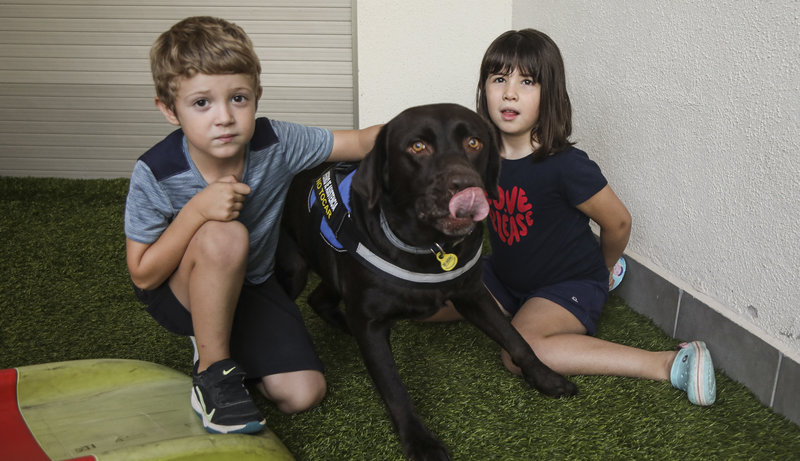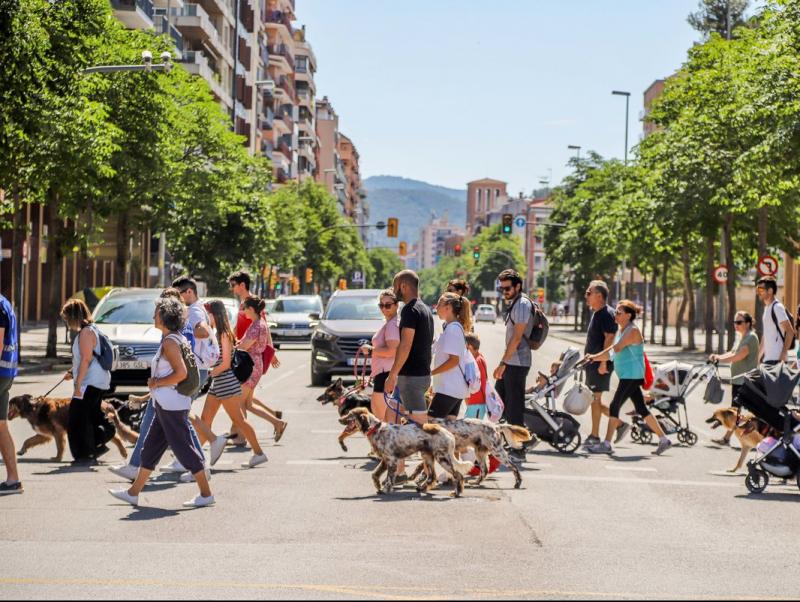More than a best friend
Although we usually associate assistance dogs with people with visual impairment, they are also an invaluable help in many other cases, such as autism and epilepsy
1 2 3 4 5 1 2 3 4
ASSISTANCE DOGS MUST BE STABLE FROM AN EMOTIONAL POINT OF VIEW
He’s helping the whole family.” It is difficult to better express the role played by Bruno, the assistance dog who cares for Paula, an 8-year-old girl who suffers from an autistic disorder as a result of Phelan McDermid syndrome. When they received the diagnosis, her parents, Nuria and Enric, started what they see as “an obstacle course”. After learning about cases they had seen in news and documentaries or had known firsthand, they decided to get an assistance dog for Paula. They did it through Discan, one of six approved entities in Catalonia. The process, still ongoing, is a long one. “You want him right away,” Núria says, but “it has to be trained, basic training specifically for children with autism, and then it has to adapt to its new environment.” They tried to speed up the process because their daughter has had to be admitted to hospital three times in recent months. They have been in the final phase for a year and seven months now. At first, Bruno stayed as a companion dog, but two weeks later the coupling process began with the instructors to adapt Bruno to Paula’s moods.
Since the end of July, Bruno has lived with them and has become another member of the family, to the point that he not only helps Paula calm down more quickly or prevent her recurring forays onto the streets, but he also interacts with the rest of the family. On the one hand, he is “helping Paula’s brother, Marc, who’s five, to process the situation he’s experiencing”. For now, Bruno plays with him, but Marc is beginning to learn that Paula is the priority. Bruno also interacts with Paula’s grandmother, who has Alzheimer’s and lives with them: “Some mornings, when gran hasn’t got up on time, Bruno goes into her room and doesn’t leave until she touches him and he knows that everything’s fine. He’s very intuitive and super intelligent,” explains Núria. Their opinion of Bruno leaves no room for doubt: “It’s not just a matter of working with Paula and being there for her. It’s about helping us all to live through the situation better together.”
There are 283 assistance dogs in Catalonia, according to the Department of Social Rights. Many (212) are guide dogs, helping people with visual disabilities. That is the most common image we have of them, quickly identified on the streets of our cities or towns, but there are also some, like Bruno, who work with autistic people (31). Or with sound signalling, that is, they are trained to warn people with hearing impairments of different sounds and indicate their source of origin; or service dogs (25), which assist people with mobility difficulties; or warning dogs (12), which give medical alerts for people who suffer from seizures due to epilepsy, diabetes or cerebral syncope, such as Virginia, who frequently faints.
Virginia, who suffers from agoraphobia as a result of her illness, got her assistance dog by chance, in a very atypical way. A few years ago, her dog died and she decided to adopt a Labrador, Lucky, to have a companion dog. After three months, however, she began to realise that, without having trained him, the dog would indicate when one of her episodes was beginning. She soon contacted Discan and sent Lucky to complete the training on how to send out certain warning signs. Thus her companion dog became an assistance dog and an inseparable helper. Aside from warning, Lucky has other abilities, such as picking things up with his mouth or helping Virginia go outside. The most precious benefit he gives her is the “confidence to go out”; Virginia went a year and a half without leaving home before Lucky arrived. “When he warns me, I know I’m going to faint immediately. So I can prepare. I sit on the floor, stretch my legs and pass out for a few seconds. During this process, Lucky stays by my side.”
Another case is that of Cristina, who was born with cerebral palsy and has mobility problems. She never imagined sharing her life with a dog. In fact, both she and her husband were fearful of the idea. But in the summer of 2019, while on holiday in San Sebastián, they came across a man accompanied by a labrador who was not even an assistance dog. That fortuitous encounter was a revelation. Cristina told her husband and daughter that she would like an assistance dog. On her return she began to look for information and stumbled upon Discan, which she contacted. The adaptation process with her assistance dog, Baileys, has been progressive: first at the Discan facilities and later at home. Two years on, Baileys has stayed for good, as another member of the family.
The dog does not have a harness, but it does have a lead, giving her the assurance that she does not have to walk the streets, cross pedestrian crossings or climb stairs alone. It also helps her if she falls. Although Baileys has become her travel companion, Cristina tells us that he is not always “in work mode” and is also a companion dog like any other.
Guide dogs
The most common assistance dogs are guide dogs, which support people with visual impairment. Many come from the Once organisation, which tests potential users, trains the dogs and carries out the adaptation and monitoring process. Isaac Padrós and David Abad are two of the 283 users in Catalonia. Isaac has a guide dog, Guilty, which has greatly increased his confidence and autonomy, to the point that he now walks up to 10 kilometres a day in his home city of Girona: the dog goes with him to take his daughter to school, to Girona University Law Faculty, where he studies, and also to the swimming pool. “A walk that used to make me very nervous, I can now enjoy from the moment I say, ’let’s go Guilty!’” he says. David has had two guide dogs: Puka and Nit. He stresses their “ability to find crossings and, above all, to dodge obstacles”.
Feature Animals
Feature Animals











